Under the rapid development and popularization of mobile internet and smart terminals, network hotspots and blind spots urgently need flexible solutions to improve coverage. Due to the increasing difficulty in site selection and engineering construction, construction costs are becoming higher and higher, and integration, miniaturization, low power consumption, low cost, controllability and intelligence of base station equipment will be the mainstream trend. A series of miniaturized base station equipment and technology Small-Cell (small base station) was born. Small-Cell originated from the Femto-Cell technology originally designed for the home, and now extends to the enterprise Pico-Cell, the city Metro-Cell, and the modern Micro-Cell.
Why choose Small-Cell because it can be applied to different terrains and can be used in both home and business. It also provides better coverage (range of 10 meters to 200 meters), capacity, which can be used to complement the weak area of ​​the macro base station signal, and is easier to deploy and schedule. More and more people want to use mobile phones anywhere, which makes mobile data more indoors and growing, while Macro-Ccell has poor indoor coverage, but Small-Cell coverage is better. .
Small Cell has lower operating costs, maintenance and power costs compared to Macro Cell, so it has lower operating costs. Studies have shown that operators generally expect that Small-Cell will play a more important role than Macro-Ccell in the future network market.
With the growth of mobile data traffic, operators generally believe that offloading mobile data is a good way to use wireless spectrum resources efficiently. Small-cell is an important component of 3G data offloading. They also think that Small-Cell is an effective way to manage LTE A spectrum, not just using Macro-Cell to manage LTE A spectrum. Mobile operators are looking for smaller base stations and Wi-Fi hotspots to better cover outdoor locations and densely populated areas, and Wi-Fi-enabled solutions will certainly help operators save valuable frequency band resources.
The Xilinx ZynqTM-7000 family of devices combines processor software with programmable SoCs for FPGA hardware to increase system integration, performance, flexibility, and scalability. The ZynqTM-7000 family of devices delivers power reduction, lower cost, and faster speeds to the market at the system level. Compared with the traditional SoC solution, Zynq-7000 Soc device development allows designers to flexibly add different peripherals and hardware accelerators according to different application scenarios to achieve optimization and differentiation goals.
1 Xilinx ZynqTM-7000 SoC Series OverviewThe Xilinx Zynq-7000 SoC Series utilizes the Xilinx 7 Series 28nm technology. The Zynq-7010 and Zynq-7020 are ArTIxTM-7 FPGA-based SoC devices that offer lower power and cost. The Zynq-7030, Zynq-7045 and Zynq-7100 are KintexTM-7 FPGA-based SoC devices that deliver higher performance and I/O rates. The device list is shown in Figure 1.
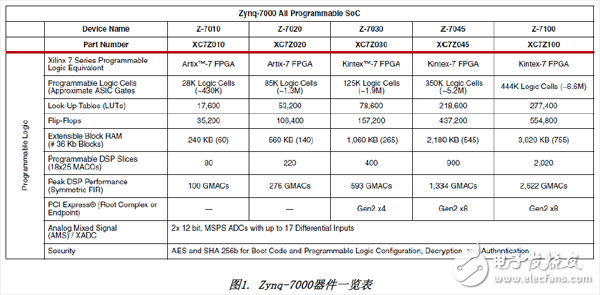
The Xilinx Zynq-7000 SoC includes both Processing System (PS) and Programmable Logic (PL). The Processing System (PS) is:
• Based on dual-core ARM CortexTM-A9
• CPU clocked up to 1GHz
• With NEON Accelerator • Supports single-precision, double-precision floating-point units • 32kB instructions and 32kB data L1 Cache
• 512kB L2 Cache
The Xilinx Zynq-7000 SoC function is shown in Figure 2.
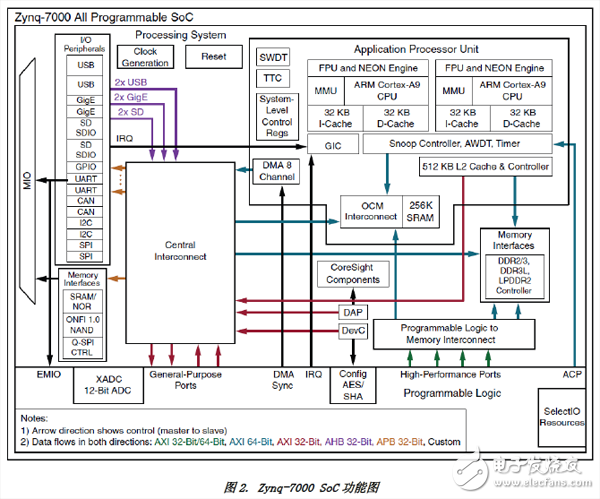
The Xilinx Zynq-7000 architecture makes it possible to implement the logic and software of the customer in both PL and PS. PS and PL are integrated in one FPGA. Due to their limited I/O bandwidth, latency and power consumption can be achieved with performance metrics that are not possible with traditional two-chip SoCs (ASSP + FPGAs), allowing customers to implement unique, differentiated system functions.
2 Xilinx Zynq-7000 SoC for LTE Small-Cell Solution OverviewThe Xilinx Zynq-7000 SoC solution addresses the needs of LTE Small-Cell applications from Pico-Cell to Macrocell. In the division of functional modules, Zynq PS software is used to implement most of the layer 2, 3 protocols. If necessary, layer 2 and 3 functions can also be accelerated by Zynq PL. Layer 1 is implemented in Zynq PL hardware.
Because there are no fans in the Small-Cell chassis, thermal issues are challenging, and the low power consumption of the Xilinx LTE Small-Cell solution helps reduce the cost of expensive heat sinks and makes thermal design simpler. Xilinx's Radio IP CFR/DPD can help customers improve amplifier efficiency and reduce the power consumption of Small-Cell. With the IPs provided by Xilinx, you can increase integration and accelerate time-to-market for your customers' products.
The Xilinx Zynq-7000 SoC solution can support the configuration of the LTE Small-Cell as shown in Figure 3.
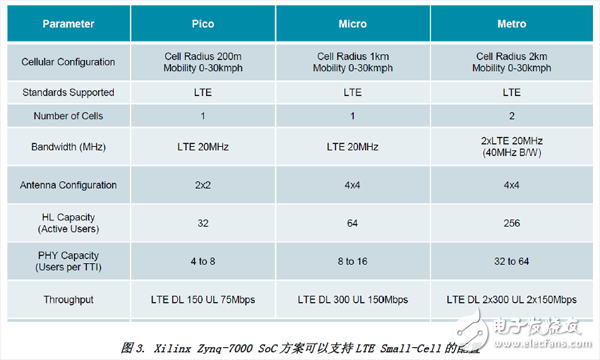
The Xilinx Zynq SoC is ideal for high performance LTE SmallCel products. The Zynq SoC has two ARM CortexTM-A9s. One ARM core implements real-time operating system, LTE layer 1 control, and another ARM core implements layer 2, 3 protocols, including IEEE1588, PDCP, RLC, MAC and PHY API, Ethernet, IP SEC/IP, UDP, SCTP, GTP -U, OA&M; Layer 1, including hardware accelerator, Channel Encoding, QAM ModulaTIon, MIMO Encoder, OFDM ModulaTIon, DUC, CFR, DPD, can be implemented in Zynq PL (low latency, high parallelism, high bandwidth interconnect). DDC, OFDM DemodulaTIon, MIMO Decoder, QAM Demodulation, Channel Decoding. JESD interface. Modules in the PS and modules in the PL can interact with data via the AXI-4 standard bus.
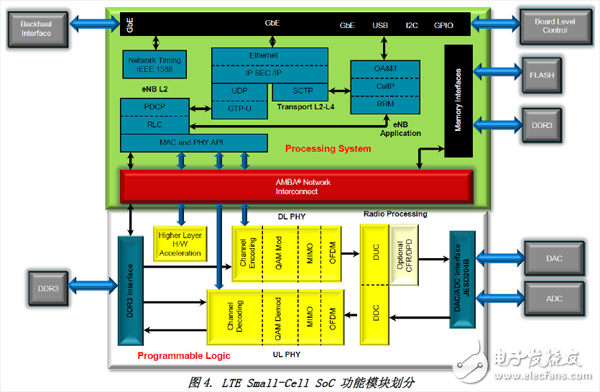
As shown in Figure 5, the upper left corner is a traditional solution using a multi-core SoC, ASSP implements a digital intermediate frequency, and a small-capacity FPGA implements the remaining interface logic and storage. This combined solution supports 2x2 (2T 2R) LTE Small-Cell. .
The lower left corner uses the xilinx single-chip Zynq Z-7045 to implement 2x2 (2T 2R) LTE Small-Cell, two ARM CortexTM-A9 processor cores to implement real-time operating system, LTE layer 1 control, layer 2, 3 protocol; Zynq logic implements the LTE layer 1 physical layer and digital intermediate frequency (DUC/DDC/CFR/DPD) and CPRI interfaces. This integrates from a traditional 3-chip to a Zynq Z-7045.
As shown in Figure 5, the benefits of integrating three chips into one are: reducing processing latency between chips, reducing BOM costs by 25%, while reducing overall power consumption by 35%.
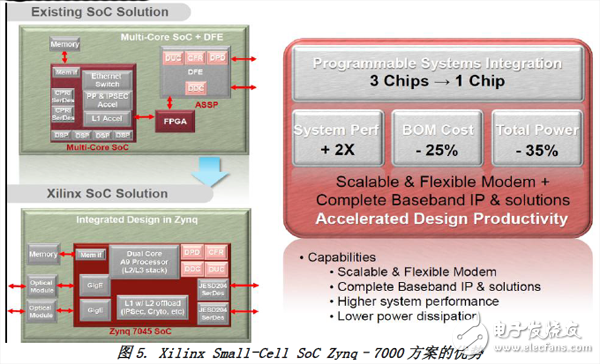
LTE Small-Cell requires low cost, low power consumption, high integration and high reliability. Full integration, scalability and flexibility are very important goals. Utilizing the Xilinx Zynq-7000 dual-core ARM processor PS, combined with high system performance and low power PL, the Xilinx All-Programmable Zynq-7000 SoC is a good solution for LTE Small-Cell now or in the future.
Not only fashionable, but also protective. Our protective sleeves provide impact protection, shock absorption and a slim design. The Phone Case can give you peace of mind and provide better protection. If you keep your phone clean and scratch-free, you can also increase the resale value of your phone.
Design: The fit design makes your phone slimmer.
Protection: These Mobile Phone Case have been tested to withstand those accidental drops. The inner layer is made of Soft TPU rubber material, and the reinforced corners can absorb impact. High lips recess your screen and camera to provide additional protection. The outer hard shell is impact resistant.
Function: When all ports can be accessed, your phone can be used normally. The Cell Phone Case has molds for volume buttons and power buttons, so it is protected and you can still feel/use them.
If you want to know more about Mobile Phone Case products, please click the product details to view the parameters, models, pictures, prices and other information about Mobile Phone Case.
Whether you are a group or an individual, we will try our best to provide you with accurate and comprehensive information about the Mobile Phone Case!
Matte Phone Case, Marble Phone Case, Protective Case, Iphone Case, Transparent Phone Case, Protective Cover
Shenzhen Jianjiantong Technology Co., Ltd. , https://www.jjthydrogelprotector.com